Detection of Critical LUCC Indices and Sensitive Watershed Regions Related to Lake Algal Blooms: A Case Study of Taihu Lake
Abstract
:1. Introduction
2. Material and Methods
2.1. Study Site
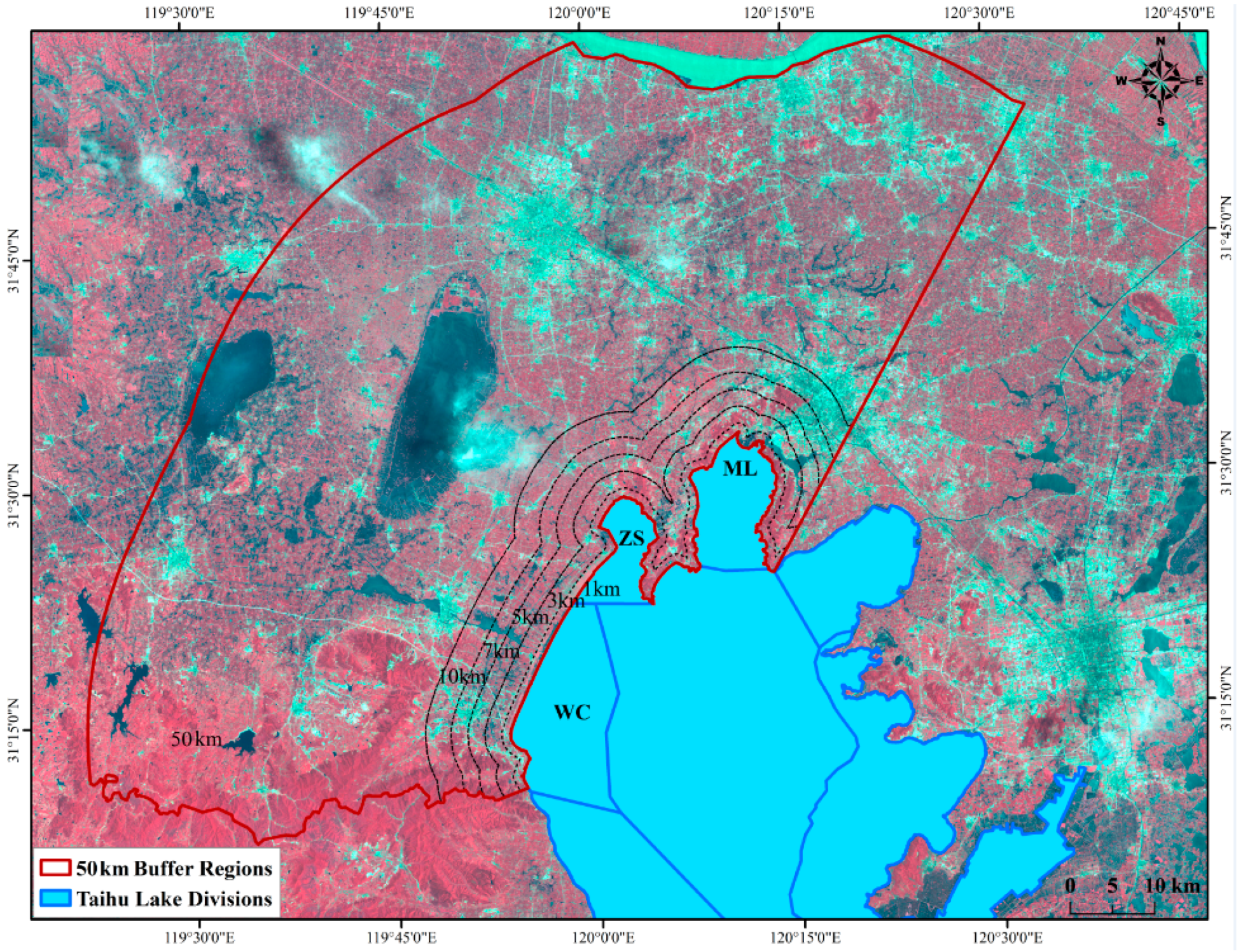
2.2. Land use/cover change (LUCC) Indices
2.3. Extraction of Algal Area from Remote Sensing Images
2.4. The Relationship between Land Use/Cover Change (LUCC) and Algae Area
3. Results
3.1. Changes in Land Use/Cover change (LUCC) over 20 Years
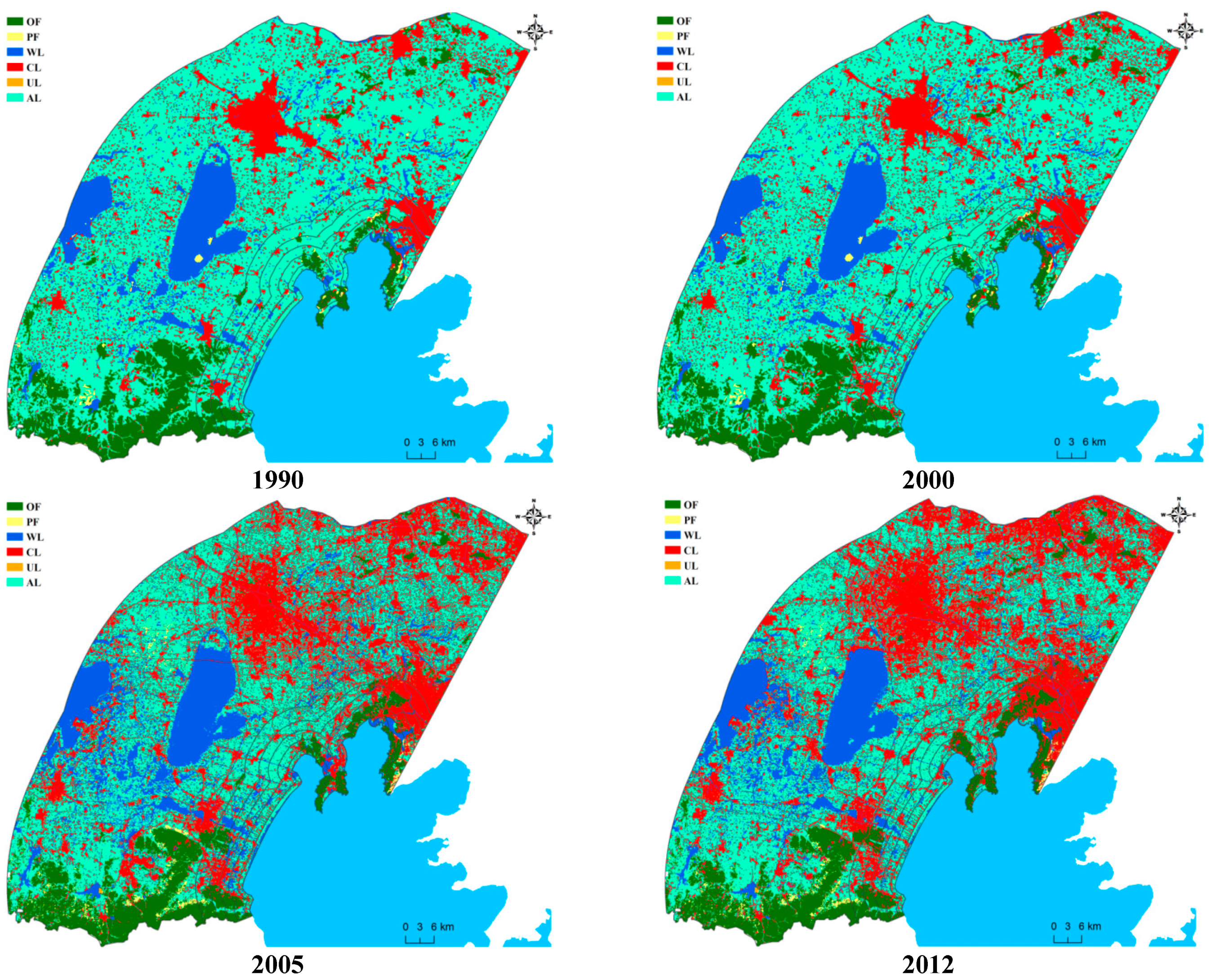
| Region | Year | OF % | PF % | AL % | CL % | WL % | UL % |
|---|---|---|---|---|---|---|---|
| WC | 1980 | 27.49 | 1.02 | 41.02 | 17.02 | 13.40 | 0.05 |
| 1995 | 27.72 | 1.08 | 39.51 | 19.29 | 11.25 | 1.15 | |
| 2000 | 26.95 | 1.14 | 40.01 | 18.56 | 12.59 | 0.75 | |
| 2002 | 23.94 | 4.55 | 34.87 | 22.12 | 14.22 | 0.30 | |
| 2005 | 22.08 | 1.51 | 34.63 | 13.34 | 15.22 | 13.22 | |
| 2008 | 22.50 | 6.41 | 37.46 | 15.75 | 7.73 | 10.15 | |
| 2010 | 21.87 | 2.97 | 39.22 | 16.52 | 9.86 | 9.56 | |
| 2012 | 16.45 | 5.21 | 34.38 | 22.93 | 10.33 | 10.70 | |
| ML | 1980 | 18.14 | 3.21 | 46.54 | 22.30 | 6.33 | 3.48 |
| 1995 | 19.33 | 4.88 | 43.90 | 22.60 | 8.47 | 0.81 | |
| 2000 | 20.73 | 1.55 | 42.25 | 23.91 | 10.62 | 0.94 | |
| 2002 | 18.65 | 2.41 | 37.92 | 30.75 | 8.33 | 1.94 | |
| 2005 | 17.95 | 1.65 | 35.26 | 37.38 | 5.95 | 1.80 | |
| 2008 | 16.76 | 1.85 | 33.41 | 36.11 | 9.68 | 2.19 | |
| 2010 | 15.94 | 1.62 | 35.33 | 39.90 | 6.11 | 2.10 | |
| 2012 | 15.78 | 2.64 | 30.16 | 44.97 | 6.28 | 0.16 | |
| ZS | 1980 | 13.79 | 0.66 | 39.36 | 16.24 | 20.89 | 9.06 |
| 1995 | 14.00 | 0.72 | 37.57 | 17.87 | 22.19 | 7.66 | |
| 2000 | 12.21 | 0.79 | 33.77 | 24.49 | 22.48 | 6.26 | |
| 2002 | 11.02 | 2.82 | 28.68 | 28.68 | 23.13 | 5.67 | |
| 2005 | 12.58 | 0.75 | 26.98 | 30.67 | 19.89 | 9.13 | |
| 2008 | 11.55 | 0.98 | 27.92 | 31.08 | 18.39 | 10.08 | |
| 2010 | 10.33 | 0.76 | 26.55 | 34.30 | 17.16 | 10.90 | |
| 2012 | 11.00 | 3.79 | 25.66 | 36.09 | 18.39 | 5.07 |
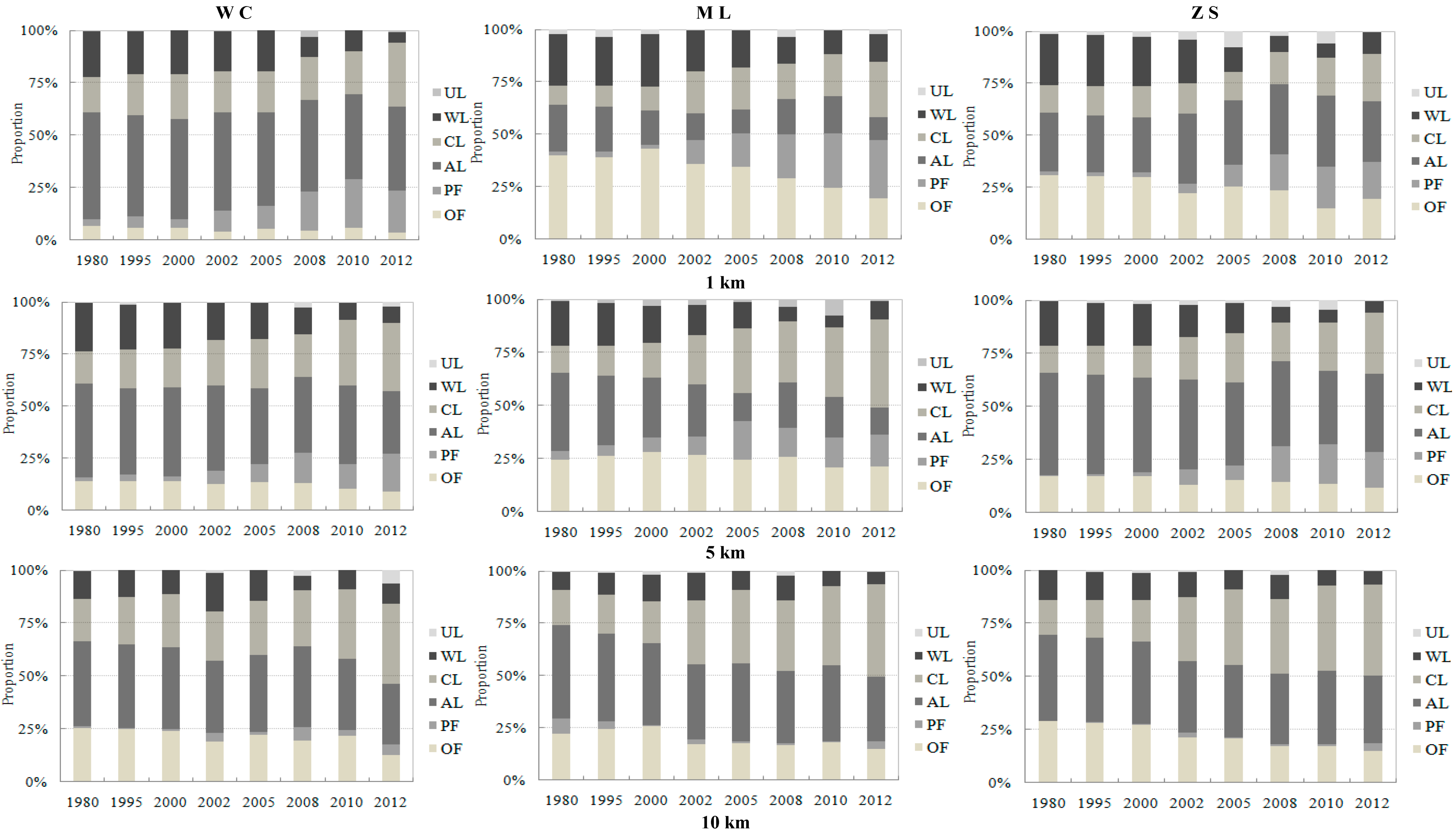
| Region | Year | B1 (1 km) | B3 (5 km) | B5 (10 km) | |||||||||
|---|---|---|---|---|---|---|---|---|---|---|---|---|---|
| SHDI | SHEI | Ci | FRAC | SHDI | SHEI | Ci | FRAC | SHDI | SHEI | Ci | FRAC | ||
| WC | 1980 | 1.079 | 0.715 | 6.558 | 1.0724 | 1.269 | 0.725 | 2.691 | 1.0684 | 1.296 | 0.699 | 2.049 | 1.0548 |
| 1995 | 1.112 | 0.737 | 6.153 | 1.0625 | 1.295 | 0.737 | 2.610 | 1.0796 | 1.341 | 0.743 | 2.008 | 1.0684 | |
| 2000 | 1.183 | 0.735 | 12.677 | 1.0898 | 1.252 | 0.778 | 3.915 | 1.0783 | 1.311 | 0.732 | 2.661 | 1.0645 | |
| 2002 | 1.427 | 0.797 | 15.382 | 1.0373 | 1.409 | 0.820 | 4.456 | 1.0349 | 1.523 | 0.850 | 2.931 | 1.0347 | |
| 2005 | 1.190 | 0.740 | 12.137 | 1.0988 | 1.308 | 0.813 | 3.807 | 1.0775 | 1.360 | 0.759 | 2.606 | 1.0663 | |
| 2008 | 1.492 | 0.833 | 17.005 | 1.0397 | 1.429 | 0.837 | 5.290 | 1.0375 | 1.567 | 0.875 | 3.093 | 1.0388 | |
| 2010 | 1.042 | 0.648 | 16.870 | 1.087 | 1.329 | 0.757 | 5.329 | 1.0752 | 1.297 | 0.724 | 3.026 | 1.062 | |
| 2012 | 1.277 | 0.713 | 22.955 | 1.1173 | 1.455 | 0.812 | 5.770 | 1.0348 | 1.395 | 0.867 | 3.088 | 1.0328 | |
| ML | 1980 | 1.266 | 0.786 | 2.975 | 1.0427 | 1.375 | 0.732 | 1.785 | 1.0436 | 1.285 | 0.756 | 1.524 | 1.0254 |
| 1995 | 1.294 | 0.815 | 2.832 | 1.0578 | 1.435 | 0.783 | 1.699 | 1.0874 | 1.348 | 0.793 | 1.451 | 1.0545 | |
| 2000 | 1.288 | 0.801 | 3.498 | 1.0654 | 1.411 | 0.787 | 2.099 | 1.0623 | 1.317 | 0.735 | 1.792 | 1.0613 | |
| 2002 | 1.522 | 0.946 | 4.046 | 1.0418 | 1.588 | 0.886 | 2.427 | 1.0358 | 1.531 | 0.855 | 2.072 | 1.0338 | |
| 2005 | 1.240 | 0.770 | 6.640 | 1.0678 | 1.376 | 0.855 | 3.084 | 1.0492 | 1.316 | 0.735 | 3.401 | 1.0388 | |
| 2008 | 1.605 | 0.896 | 7.925 | 1.0433 | 1.635 | 0.913 | 4.455 | 1.0417 | 1.588 | 0.886 | 3.803 | 1.0403 | |
| 2010 | 1.230 | 0.764 | 8.448 | 1.0689 | 1.327 | 0.824 | 4.069 | 1.0471 | 1.278 | 0.713 | 3.327 | 1.037 | |
| 2012 | 1.466 | 0.911 | 8.257 | 1.0415 | 1.469 | 0.820 | 4.154 | 1.0363 | 1.401 | 0.782 | 3.254 | 1.0325 | |
| ZS | 1980 | 1.295 | 0.695 | 3.209 | 1.0145 | 1.201 | 0.755 | 1.925 | 1.0452 | 0.816 | 0.602 | 1.605 | 1.0351 |
| 1995 | 1.265 | 0.687 | 3.606 | 1.0257 | 1.235 | 0.812 | 2.164 | 1.0388 | 0.976 | 0.599 | 1.803 | 1.0537 | |
| 2000 | 1.316 | 0.734 | 5.654 | 1.0484 | 1.164 | 0.650 | 3.392 | 1.0587 | 0.944 | 0.527 | 2.827 | 1.0163 | |
| 2002 | 1.579 | 0.881 | 5.165 | 1.0422 | 1.513 | 0.844 | 3.099 | 1.0317 | 1.367 | 0.763 | 2.583 | 1.0353 | |
| 2005 | 1.330 | 0.959 | 5.104 | 1.0598 | 1.261 | 0.910 | 3.062 | 1.0458 | 1.108 | 0.799 | 2.552 | 1.0536 | |
| 2008 | 1.527 | 0.852 | 5.929 | 1.0785 | 1.388 | 0.774 | 3.557 | 1.0453 | 1.238 | 0.691 | 3.765 | 1.0721 | |
| 2010 | 1.321 | 0.953 | 6.235 | 1.0964 | 1.190 | 0.859 | 3.141 | 1.0564 | 1.071 | 0.773 | 3.117 | 1.0987 | |
| 2012 | 1.403 | 0.878 | 6.108 | 1.1025 | 1.476 | 0.824 | 3.065 | 1.0324 | 1.365 | 0.762 | 3.154 | 1.1163 | |
3.2. Changes in Algae Area over 20 years
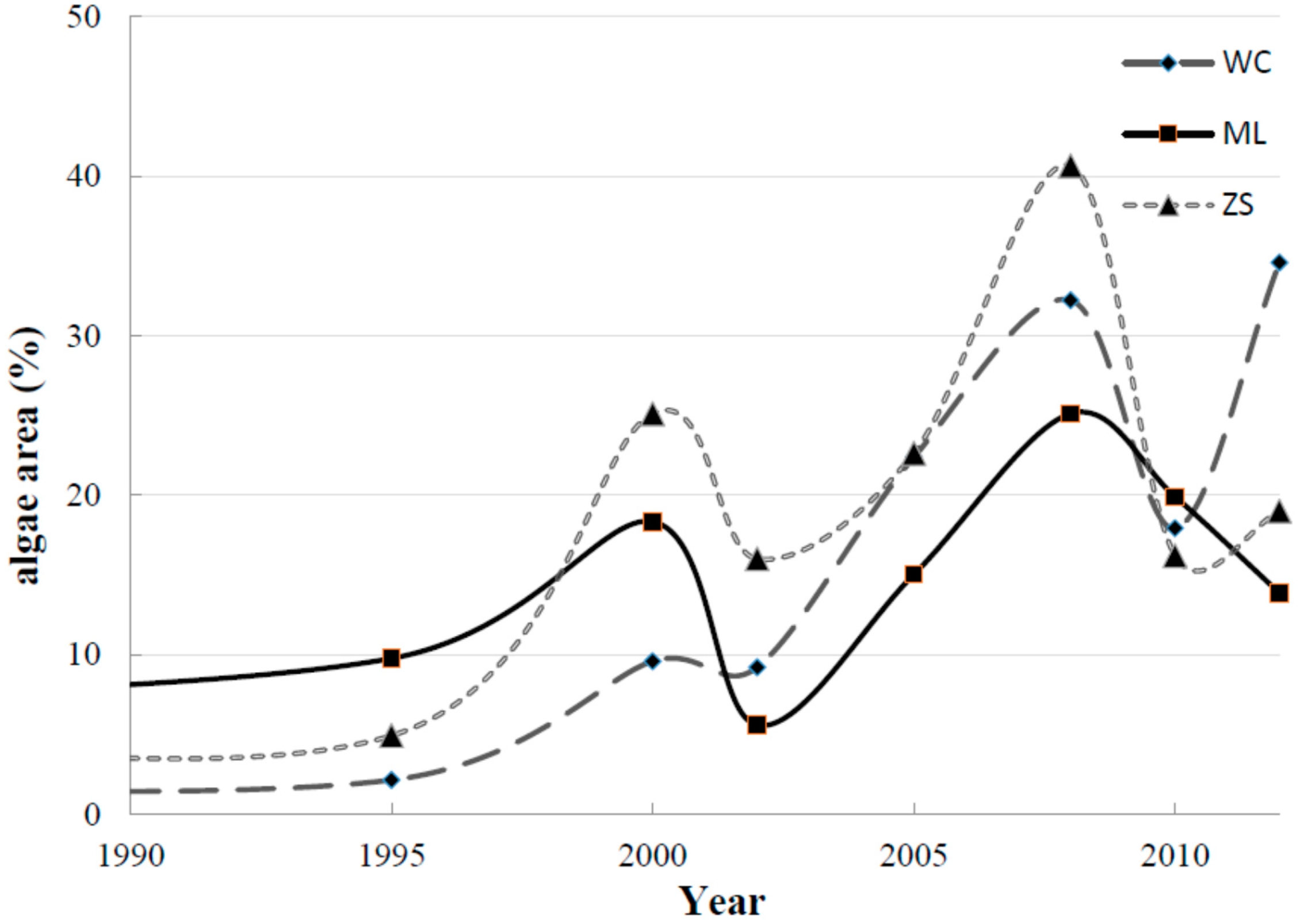
3.3. Relationship between Land Use/Cover change and (LUCC) Algae areas
| Buffer Region | Distance to Lake | n | R2 | RMSE | Significant Factors | |
|---|---|---|---|---|---|---|
| Land Use | Landscape | |||||
| B1 | 1 km | 24 | 0.44 | 6.78 | WL | SHDI |
| B2 | 3 km | 24 | 0.66 | 3.73 | WL, PF | SHDI |
| B3 | 5 km | 24 | 0.58 | 8.21 | WL, AL | -- |
| B4 | 7 km | 24 | 0.52 | 8.39 | AL | Ci |
| B5 | 10 km | 24 | 0.50 | 7.53 | AL, WL | Ci |
| B6 | 50 km | 24 | 0.23 | 9.04 | -- | Ci |

| Buffer Region | B1 | B2 | B3 | B4 | B5 | B6 | ||||||
|---|---|---|---|---|---|---|---|---|---|---|---|---|
| R2 | Factor | R2 | Factor | R2 | Factor | R2 | Factor | R2 | Factor | R2 | Factor | |
| WC | 0.67 | WL | 0.59 | WL | 0.42 | AL, WL | 0.43 | AL | 0.38 | Ci, SHDI | 0.23 | AL, Ci |
| ML | 0.59 | WL, SHDI | 0.89 | WL, SHDI | 0.85 | WL, AL, Ci | 0.80 | AL, WL, Ci | 0.60 | Ci | 0.31 | Ci |
| ZS | 0.48 | WL | 0.82 | AL, WL, SHDI | 0.90 | AL, SHDI, Ci | 0.55 | Ci | 0.60 | AL, Ci | 0.20 | AL, Ci |
4. Discussion
4.1. Critical Land Use/Cover change (LUCC) Indices Affecting Lake Algal Blooms in Different Lake Divisions
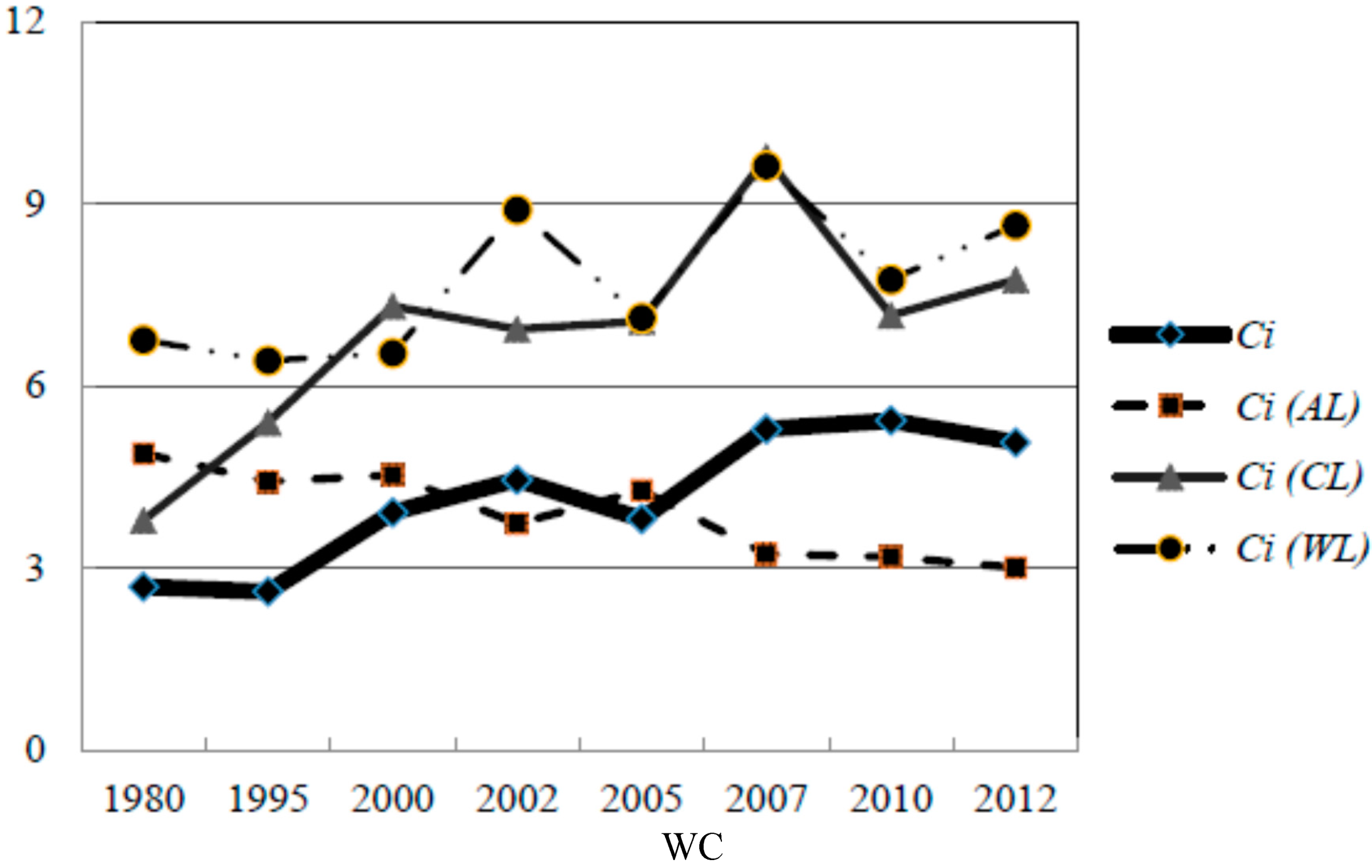
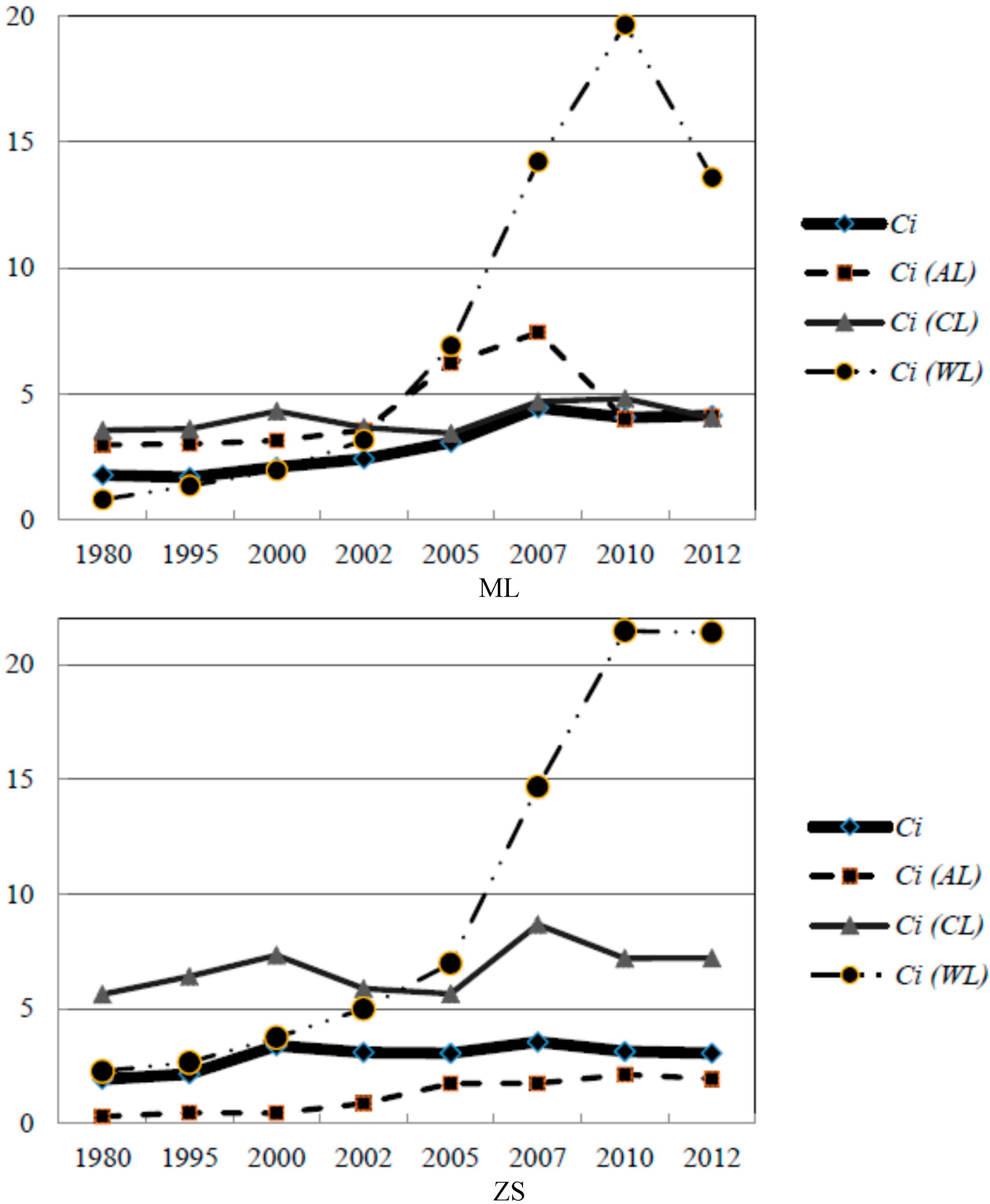
4.2. The Relationship between Land Use/Cover Change (LUCC) and Algal Blooms for Different Lake Divisions and Buffer regions
5. Conclusions
Acknowledgments
Author Contributions
Conflicts of Interest
References
- Naiman, R.J.; Magnuson, J.J.; McKnight, D.M.; Stanford, J.A. The Fresh-Water Imperative: A Research Agenda; Island Press: Washington, DC, USA, 1995. [Google Scholar]
- Stenseth, N.C.; Mysterud, A.; Ottesen, J.G.; Hurrell, W.; Chan, K.S.; Lima, M. Ecological effects of climate fluctuations. Science 2002, 297, 1292–1296. [Google Scholar] [PubMed]
- Erol, A.; Randhir, T.O. Watershed ecosystem modeling of land-use impacts on water quality. Ecol. Model. 2013, 270, 54–63. [Google Scholar] [CrossRef]
- Gibson, G.; Carlson, R.; Simpson, J.; Smeltzer, E.; Gerritson, J.; Chapra, S.; Heiskary, S.; Jones, J.; Kennedy, R. Nutrient Criteria-Technical Guidance Manual: Lakesand Reservoirs; Environmental Protection Agency: Washington, DC, USA, 2000. [Google Scholar]
- Norton, L.; Elliott, J.A.; Maberly, S.C.; May, L. Using models to bridge the gap between land use and algal blooms: An example from the Loweswater Catchment, UK. Environ. Modell. Softw. 2012, 36, 64–75. [Google Scholar] [CrossRef] [Green Version]
- Palmer, M.; Bernhardt, E.; Chornesky, E. Ecology for a crowded planet. Science 2004, 304, 1251–1252. [Google Scholar] [CrossRef] [PubMed]
- Jones, J.R.; Knowlton, M.F.; Obrecht, D.V.; Cook, E.A. Importance of landscape variables and morphology on nutrients in Missouri reservoirs. Can. J. Fish. Aquati. Sci. 2004, 61, 1503–1512. [Google Scholar] [CrossRef]
- Tong, S.T.Y.; Chen, W.L. Modeling the relationship between land-use and surface water quality. J. Environ. Manag. 2002, 66, 377–393. [Google Scholar] [CrossRef]
- Wang, X. Integrating water-quality management and land-use planning in a watershed context. J. Environ. Manag. 2001, 61, 25–36. [Google Scholar] [CrossRef]
- Amiri, B.J.; Nakane, K. Modeling the linkage between river water quality and landscape metrics in the Chugoku district of Japan. Water Resour. Manag. 2009, 23, 931–956. [Google Scholar] [CrossRef]
- Martinez, J.M.A.; Seoane, S.S.; Calabuig, E.D.L. Modelling the risk of land cover change from environmental and socio-economic drivers in heterogeneous and changing landscapes: The role of uncertainty. Landscape Urban Plan. 2011, 101, 108–119. [Google Scholar]
- Guo, Q.H.; Ma, K.M.; Zhang, Y. Impact of land use pattern on lake water quality in urban region. Acta Ecol. Sin. 2009, 29, 776–787. [Google Scholar]
- Weller, D.E.; Jordan, T.E.; Correll, D.L.; Liu, Z.J. Effects of land-use change on nutrient discharges from the Patuxent River watershed. Estuaries 2003, 26, 244–266. [Google Scholar] [CrossRef]
- Yang, X.J. An assessment of landscape characteristics affecting estuarine nitrogen loading in an urban watershed. J. Environ. Manag. 2012, 94, 50–60. [Google Scholar] [CrossRef]
- Guo, Q.H.; Ma, K.M.; Yang, L.; He, K. Testing a dynamic complex hypothesis in the analysis of land use impact on lake water quality. Water Resour. Manag. 2010, 24, 1313–1332. [Google Scholar] [CrossRef]
- Sawyer, J.A.; Stewart, P.M.; Mullen, M.M.; Simon, T.P.; Bennett, H.H. Influence of habitat, water quality, and land use on macro-invertebrate and fish assemblages of a southeastern coastal plain watershed, USA. Aquat. Ecosyst. Health 2004, 7, 85–99. [Google Scholar] [CrossRef]
- Sliva, L.; Williams, D.D. Buffer zone vs. whole catchment approaches to studying land-use impact on river water quality. Water Resour. 2001, 35, 3462–3472. [Google Scholar]
- Hunsaker, C.T.; Levine, D.A. Hierarchical approaches to the study of water quality in rivers. BioScience 1995, 45, 193–202. [Google Scholar] [CrossRef]
- Hatfield, J.L.; McMullen, L.D.; Jones, C.S. Nitrate-nitrogen patterns in the Raccoon River Basin related to agricultural practices. J. soil water conserv. 2009, 64, 190–199. [Google Scholar] [CrossRef]
- Chang, H. Spatial analysis of water quality trends in the Han River basin, South Korea. Water Res. 2008, 42, 3285–3304. [Google Scholar] [CrossRef] [PubMed]
- Qin, B.Q.; Hu, W.P.; Chen, W.M. Evolution Process and Mechanism of Tai Lake Environment; Science Press: Beijing, China, 2004. [Google Scholar]
- Kong, F.X.; Hu, W.P.; Fan, C.X.; Wang, S.M.; Xue, B.; Gao, J.F.; Gu, X.H.; Li, H.P.; Huang, W.Y.; Chen, K.N. Research and strategic thinking for water pollution control and ecological restoration in Taihu Basin. J. Lake Sci. 2006, 18, 193–198. (in Chinese). [Google Scholar]
- Zhu, G.W. Eutrophication status and causing factors for a large, shallow and subtropical lake Taihu, China. J. Lake Sci. 2008, 20, 21–26. (in Chinese). [Google Scholar]
- Qin, B.Q.; Zhu, G.W.; Gao, G.; Zhang, Y.L.; Li, W.; Paerl, H.W.; Carmichael, W.W. A drinking water crisis in Lake Taihu, China: Linkage to climatic variability and lake management. Environ. Manag. 2010, 45, 105–112. [Google Scholar] [CrossRef]
- Yang, S.Q.; Liu, P.W. Strategy of water pollution prevention in Taihu Lake and its effects analysis. J. Great Lakes Res. 2010, 36, 150–158. [Google Scholar] [CrossRef]
- Gao, Y.N.; Gao, J.F. Delineation of aquatic eco-regions in Taihu lake basin. Geogr. Res. 2010, 29, 111–117. [Google Scholar]
- EarthExplorer. Available online: http:// earthexplorer.usgs.gov (accessed on 23 January 2015).
- McGarigal, K.; Marks, B.J. FRAGSTATS: Spatial Pattern Analysis Program for Quantifying Landscape Structure; US Department of Agriculture, Forest Service, Pacific Northwest Research Station: Washington, DC, USA, 1995. [Google Scholar]
- Hu, C.M. A novel ocean color index to detect floating algae in the global oceans. Remote Sens. Environ. 2009, 113, 2118–2129. [Google Scholar]
- Hu, C.M.; Lee, Z.P.; Ma, R.H.; Yu, K.; Li, D.Q.; Shang, S.L. Moderate resolution imaging spectroradiometer (MODIS) observations of cyanobacteria blooms in Taihu Lake, China. J Geophy. Res. 2010, 115, 841–854. [Google Scholar]
- National Aeronautics and Space Administration. Available online: https://modis.gsfc.nasa.gov (accessed on 23 January 2015).
- Duan, H.T.; Zhang, S.X.; Zhang, Y.Z. Cyanpbacteria bloom monitoring with remote sensing in Lake Taihu. J. Lake Sci. 2008, 20, 145–152. (in Chinese). [Google Scholar]
- Basnyat, P.; Teeter, L.D.; Lockaby, B.G. Relationships between landscape characteristics and nonpoint source pollution inputs to coastal estuaries. Environ. Manag. 1999, 23, 539–549. [Google Scholar] [CrossRef]
- Ferguson, C.A.; Carvalho, L.; Scott, E.M.; Bowman, A.W.; Kirika, A. Assessing ecological responses to environmental change using statistical models. J. Appl. Ecol. 2008, 45, 193–203. [Google Scholar] [CrossRef]
- Coveney, M.F.; Stites, D.L.; Lowe, E.F.; Battoe, L.E.; Conrow, R. Nutrient removal from eutrophic lake water by wetland filtration. Ecol. Eng. 2002, 19, 141–159. [Google Scholar] [CrossRef]
- Jones, J.R.; Knowlton, M.F.; Obrecht, D.V. Role of land cover and hydrology in determining nutrients in mid-continent reservoirs: Implications for nutrient criteria and management. Lake Reserv. Manag. 2008, 24, 1–9. [Google Scholar] [CrossRef]
- O’Neill, R.V.; Hunsaker, C.T.; Jones, K.B.; Riitters, K.H.; Wickham, J.D.; Schwartz, P.M.; Goodman, I.A.; Jackson, B.L.; Baillargeon, W.S. Monitoring environmental quality at the landscape scale. Bioscience 1997, 47, 513–519. [Google Scholar] [CrossRef]
- Alberti, M.; Booth, D.; Hill, K.; Coburn, B.; Avolio, C.; Coe, S.; Spirandelli, D. The impact of urban patterns on aquatic ecosystems: an empirical analysis in Puget lowland sub-basins. Landsc. Urban Plan. 2007, 80, 345–361. [Google Scholar] [CrossRef]
- Yang, Y.H.; Zhou, F.; Guo, H.C.; Sheng, H.; Liu, H.; Dao, X. Analysis of spatial and temporal water pollution patternsin Lake Dianchi using multivariate statistical methods. Environ Monit. Assess. 2010, 170, 407–416. [Google Scholar] [CrossRef] [PubMed]
- Hu, J.; Liu, M.S.; Zhou, W.; Xu, C.; Yang, X.J.; Zhang, S.W.; Wang, L. Correlations between water quality and land use pattern in Taihu Lake basin. Chinese J. of Ecol. 2011, 30, 1190–1197. (in Chinese). [Google Scholar]
- Beaver, J.R.; Manis, E.E.; Loftin, K.A.; Graham, J.L.; Pollard, A.I.; Mitchell, R.M. Land use patterns, ecoregion, and microcystin relationships in US lakes and reservoirs: A preliminary evaluation. Harmful Algae 2014, 36, 57–62. [Google Scholar] [CrossRef]
- Deng, X.; Huang, J.; Rozelle, S.; Uchida, E. Growth, population and industrialization, and urban expansion of China. J. Urban Econ. 2008, 63, 96–115. [Google Scholar] [CrossRef]
- Fraterrigo, J.M.; Downing, J.A. The influence of land use on lake nutrients varies with watershed transport capacity. Ecosystems 2008, 11, 1021–1034. [Google Scholar] [CrossRef]
- Merugu, C.S.; Seetharaman, R. Comparative analysis of land use and lake water quality in rural and urban zones of south Chennai, India. Environ. Dev. Sustain. 2013, 15, 511–528. [Google Scholar] [CrossRef]
- Catherine, A.; Mouillot, D.; Maloufi, S.; Troussellier, M.; Bernard, C. Projecting the impact of regional land-use change and water management policies on lake water quality: An application to Periurban Lakes and reservoirs. PLoS One. 2013, 8, 1–11. [Google Scholar] [CrossRef]
- Nielsen, A.; Trolle, D.; Søndergaard, M.; Lauridsen, T.L.; Bjerring, R.; Olesen, J.E.; Jeppesen, E. Watershed land use effects on lake water quality in Denmark. J. Appl. Ecol. 2012, 22, 187–1200. [Google Scholar]
- Vanni, M.J.; Renwick, W.H.; Bowling, A.M.; Horgan, M.J.; Christian, A.D. Nutrient stoichiometry of linked catchment-lake systems along a gradient of land use. Freshw. Biol. 2010, 56, 791–811. [Google Scholar] [CrossRef]
© 2015 by the authors; licensee MDPI, Basel, Switzerland. This article is an open access article distributed under the terms and conditions of the Creative Commons Attribution license (http://creativecommons.org/licenses/by/4.0/).
Share and Cite
Lin, C.; Ma, R.; Su, Z.; Zhu, Q. Detection of Critical LUCC Indices and Sensitive Watershed Regions Related to Lake Algal Blooms: A Case Study of Taihu Lake. Int. J. Environ. Res. Public Health 2015, 12, 1629-1648. https://doi.org/10.3390/ijerph120201629
Lin C, Ma R, Su Z, Zhu Q. Detection of Critical LUCC Indices and Sensitive Watershed Regions Related to Lake Algal Blooms: A Case Study of Taihu Lake. International Journal of Environmental Research and Public Health. 2015; 12(2):1629-1648. https://doi.org/10.3390/ijerph120201629
Chicago/Turabian StyleLin, Chen, Ronghua Ma, Zhihu Su, and Qing Zhu. 2015. "Detection of Critical LUCC Indices and Sensitive Watershed Regions Related to Lake Algal Blooms: A Case Study of Taihu Lake" International Journal of Environmental Research and Public Health 12, no. 2: 1629-1648. https://doi.org/10.3390/ijerph120201629





